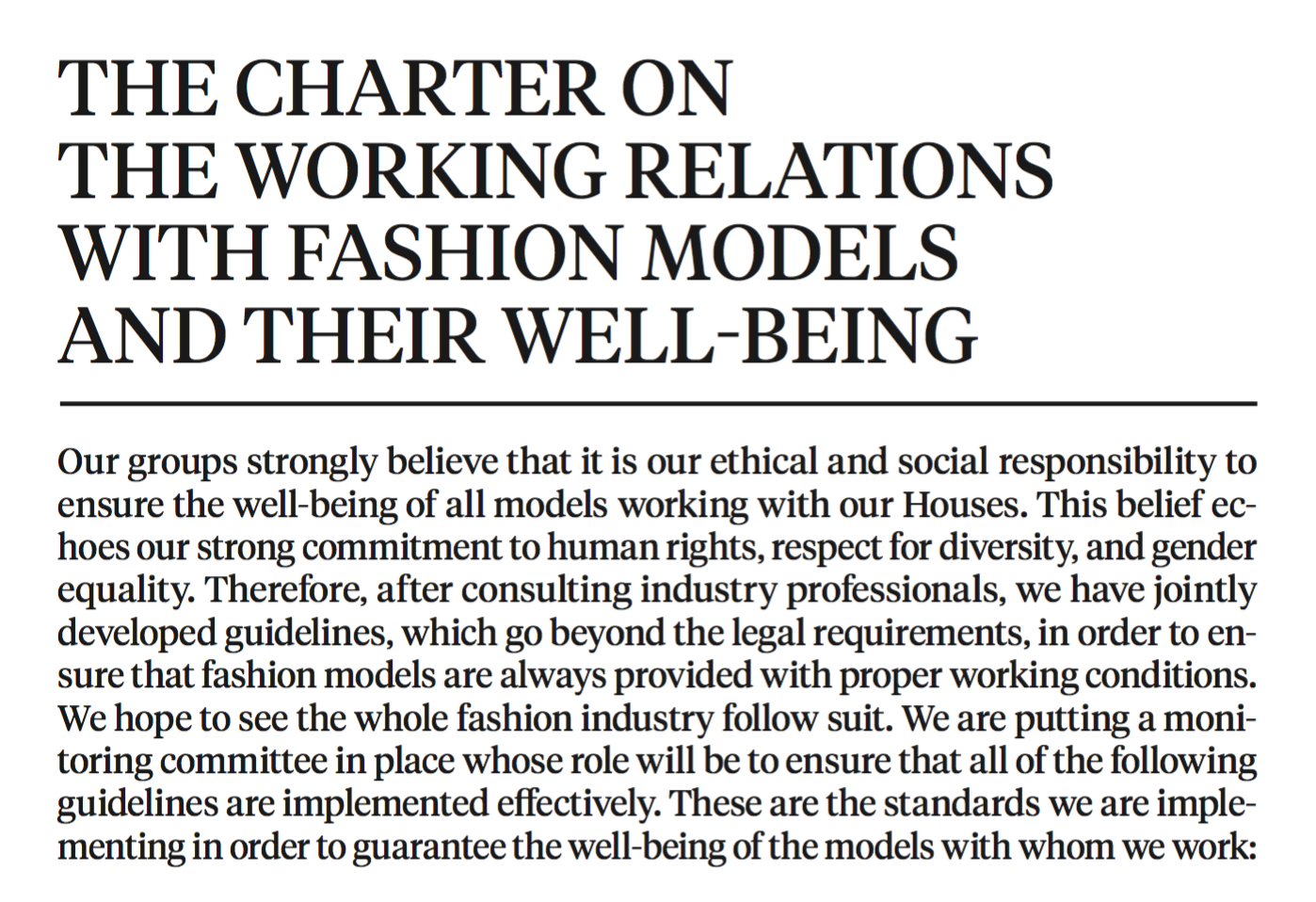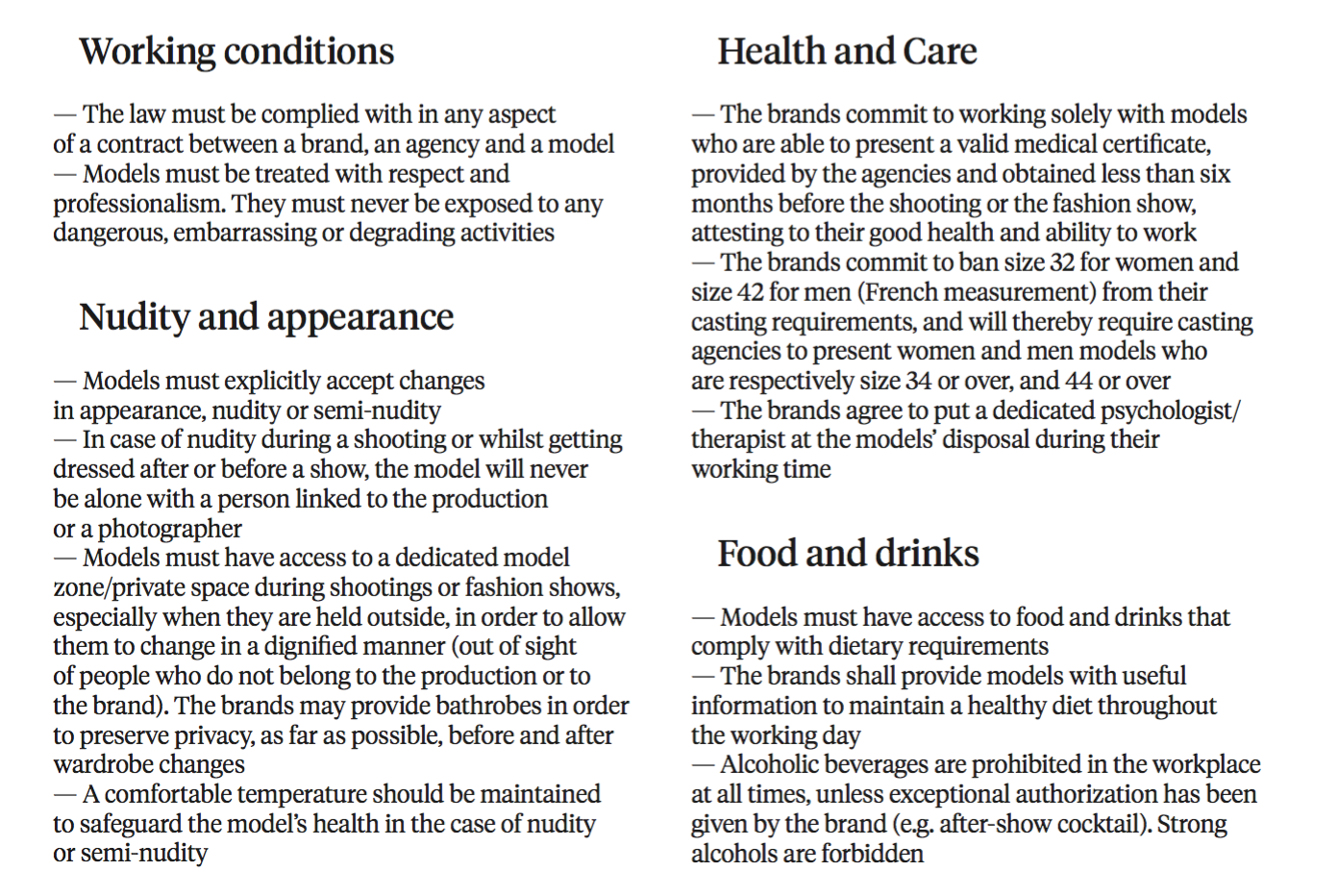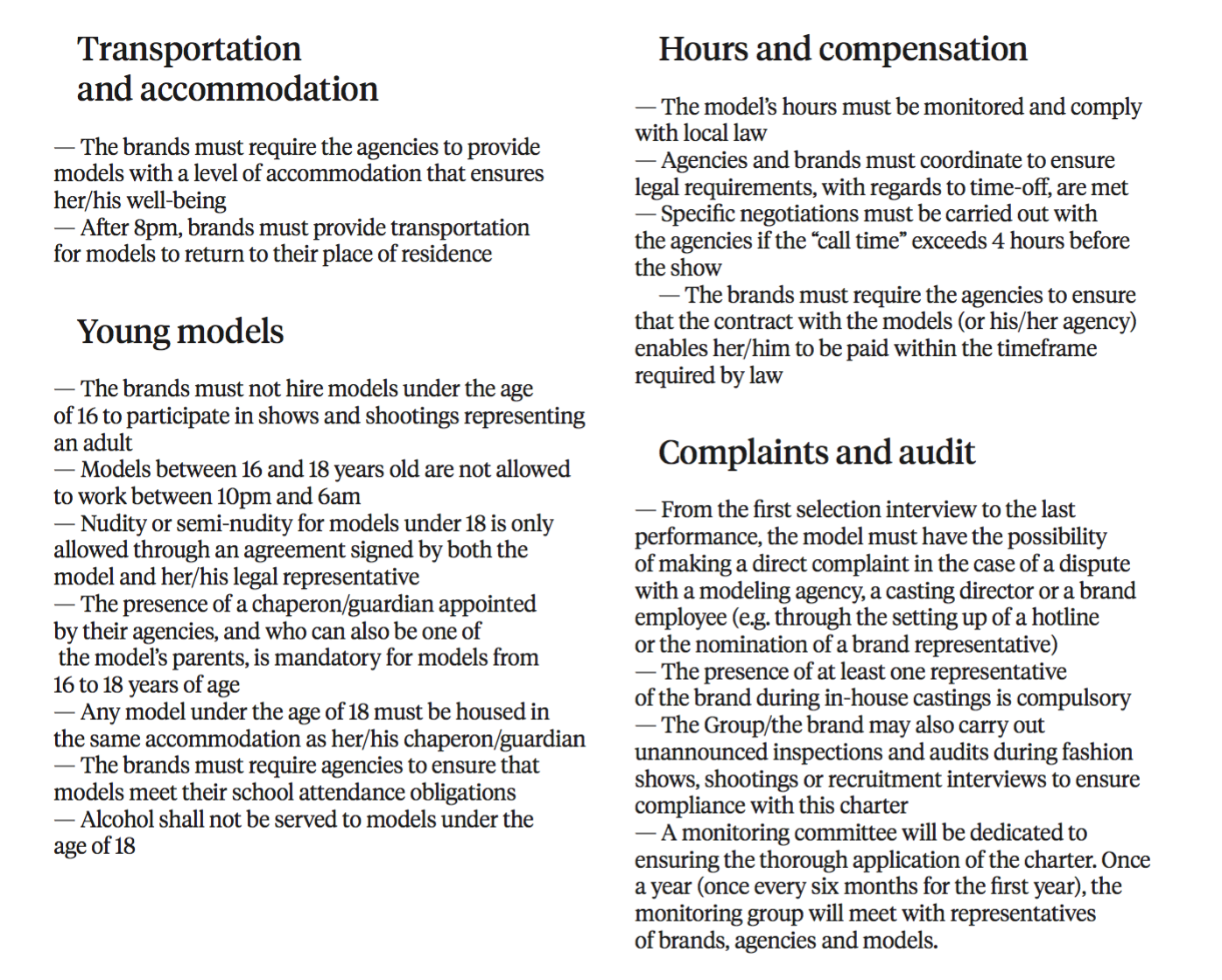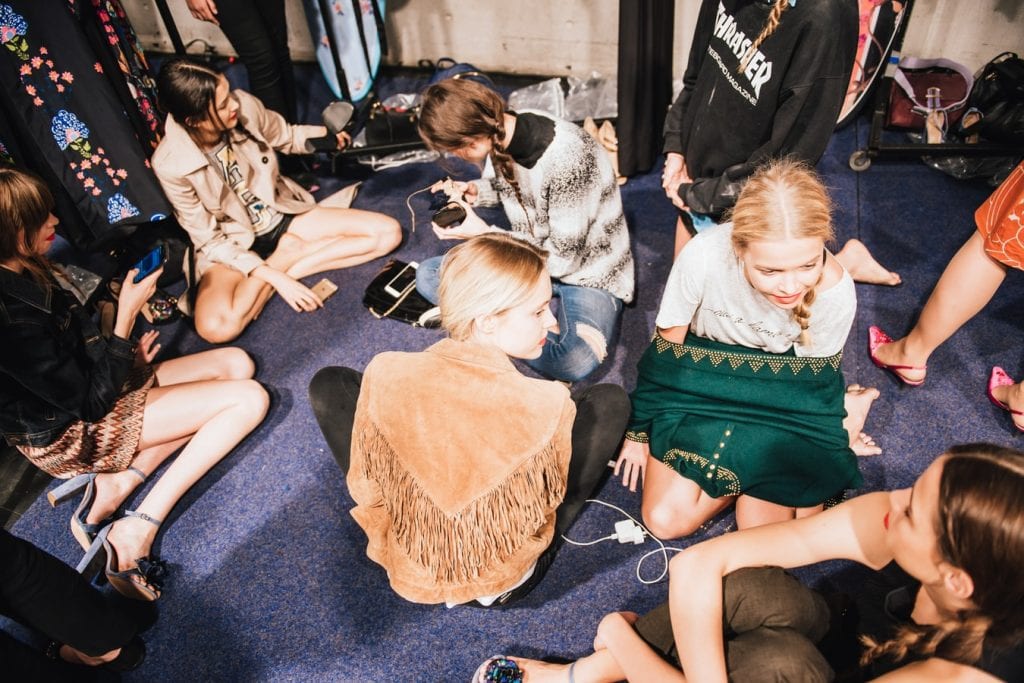Two of the fashion industry’s largest conglomerates have come together to take a stand for runway models. Kering – which owns Gucci, YSL, Balenciaga, and Bottega Veneta, among other brands – and LVMH – parent to Louis Vuitton, Celine, Givenchy, and Marc Jacobs, etc. – have established a charter for the well-being of models that will be implemented across their rosters of brands.
According to a joint statement released by the Paris-based conglomerates on Wednesday, a day before the start of the Spring/Summer 2018 shows in New York: “Respecting the dignity of every man and woman is at the heart of both group’s values. Having always cared for the well-being of models, LVMH and Kering feel that they have a specific responsibility, as leaders in the industry, to go one step further with their brands.”
The Charter
This charter, which is applicable worldwide (although not legally mandated on its own), “reflects high standards of integrity, responsibility and respect for those concerned,” according to the two fashion figures. In addition to “paying particular attention” to ensuring good working conditions for models, the charter is structured around “several major commitments,” including:
• Brands of both groups commit to working solely with models able to present a valid medical certificate, attesting to their good health and ability to work, obtained less than six months before the shooting or the fashion show;
• All fashion brands belonging to LVMH and Kering commit to banning size 32 for women and size 42 for men (French measurement) from their casting requirements. Casting agencies will be required to present female and male models who are size 34 or over, and size 44 or over, respectively. To further ensure the care of models, it will be incumbent upon the brands to put a dedicated psychologist/therapist at their disposal during their working time;
[Note: Size 32 in France corresponds to size 0 in the United States].• Models below the age of 16 must not be hired by brands to take part in shows or shootings representing an adult;
• 16 to 18 year-old models are subject to specific rules: They are not permitted to work between 10pm and 6am; The presence of a chaperon/guardian—who can be one of the model’s parents— appointed by their agency is mandatory for models aged 16 to 18, and any model under the age of 18 must be housed in the same accommodation as their chaperon/guardian; and The charter requires brands to ask agencies to ensure that models meet their school attendance obligations; and
• Models must have the possibility of making a direct complaint in the case of a dispute with a modeling agency, a casting director or a brand (e.g. through the designation of a contact person or the setting up of a hotline).
The implementation of the Charter “will start during the upcoming Fashion Weeks. A monitoring committee, made up of representatives of the brands, agencies and models, will meet each year (once every six months for the first year),” the release further notes.
An Effective Initiative?
The LVMH, Kering charter follows a handful of prior attempts by other important industry stakeholders in connection with the casting of models, all of which have been questionably effective, at best. You may recall that in 2012, Conde Nast announced that the editors of all of its Vogue magazines had vowed to stop using “underage” models (aka models under age 16) in all Vogue editorials. That vow was swiftly followed by a handful of Vogue publications featuring models under age 16 in their editorials.
Around the same time, the Council of Fashion Designers of America (“CFDA”) introduced guidelines for New York Fashion Week as part of its “Health as Beauty and Diversity” campaign to ensure the safety and legality of models in the industry. The guidelines recommend that designers require models to produce a valid ID the day they walk the runway proving that they are at least 16 years old, which – as noted by Jezebel – was the centerpiece of the CFDA’s seasonal letter to its members.
Not long thereafter, several brands that fall under the umbrella of the CFDA stepped out on the group’s own initiative. For instance, in September 2011, 15-year old model Valerija Sestic walked in more than a dozen shows during NYFW alone, including those of CFDA members Oscar de la Renta, Donna Karan, Tory Burch, Rag & Bone, Tory Burch, Phillip Lim, Carolina Herrera, Marc by Marc Jacobs and Rodarte.
With such instances in mind, it would appear prudent to question the potential efficacy of LVMH and Kering’s charter from the outset. However, there is one very important element that the groups’ charter fails to note. A French law, which per the New York Times “applies to all models working in the European Union and the European Economic Area,” already exists. That legislation mandates – and as a ratified law, formally trumps – any of the provisions set forth in the parties’ charter.
As such, almost all of the LVMH and Kering brands – the vast majority of which show in Paris and Milan and thus, are subject to European Union law – would already be legally obligated to do quite a bit of what they are vowing to in the charter.
In accordance with the aforementioned EU law, beginning on October 1, 2017, models must possess a medical certificate in order to work (one of the major tenets of the parties’ charter). In accordance with that same law, models will have to undergo a medical examination every two years and be issued with a medical certificate certifying that their they are in good enough health to work. Particular attention will be paid to their body mass index, which is calculated by dividing their weight by the square of their height.
That speaks directly to the charter’s measurement/size language and its requirement that brands only employ models “who are able to present a valid medical certificate, provided by the agencies and obtained less than six months before the shooting or the fashion show.”
As for the age-specific rules for models under age 16, these are in line with a New York-specific law – the home of LVMH’s Marc Jacobs brand – that requires that underage models be subject to special considerations, including restricted working hours, breaks after every four hours of work, and specific work permits, etc.
With these existing laws in mind, Kering and LVMH’s charter appears to be more of a declaration that the conglomerates will, in fact, follow the law, than it is a legally groundbreaking effort.
Now, none of this is to say that if these parties do, in fact, abide by the tenets of the charter (and thus, the law) that such efforts will – very practically – amount to a significant step for the industry. This is particularly true because the conglomerates at play are the two most powerful entities in the game and their vocal support for models’ well being is meaningful in and of itself.
It is imperative to acknowledge that in a handful of cases, the charter’s language goes well beyond the laws in the various jurisdictions. The requirement of agencies making a dedicated psychologist/therapist available to models, being one example, and the requirement of health certificates every six months (as opposed to two years), being another.
Moreover, it is worth stating that unlike any other major conglomerates (or other very-established brands), Kering and LVMH are, in fact, taking steps to publicly vow to uphold the declarations set forth in their charter, which is commendable and given their collective power, very well stands to make an impact in the fashion industry.



UPDATED (February 2018): LVMH and Kering have “expanded upon” their commitment to model well being by launching WeCareForModels.com, a website aimed at “empowerment, transparency and emancipation, initiated by the the Charter and provides models with information and best practices.”
In particular, the luxury giants state that they hope their charter and recently-launched website, which includes “information and advice from professionals concerning well-being, as well as first-person comments,” will serve “to encourage all the different stakeholders in the industry to actively engage with this initiative.”
The website, per Kering and LVMH, provides “a few simple daily practices and basic rules that, if followed regularly, play a fundamental role in being and remaining in top physical and mental form.” These include: “Healthy eating guidelines [for] both outside and during Fashion Weeks, a few examples of which are found in the section All About Food.”
In addition, “in the State of Mind section we talk about other kinds of equally important factors that contribute to a healthy balance such as knowing how to breathe, positive thinking, getting appropriate exercise and getting rest. These are simple tips that have been prepared with models in mind with the help of nutritionists and coaches. They can easily be applied backstage.”











